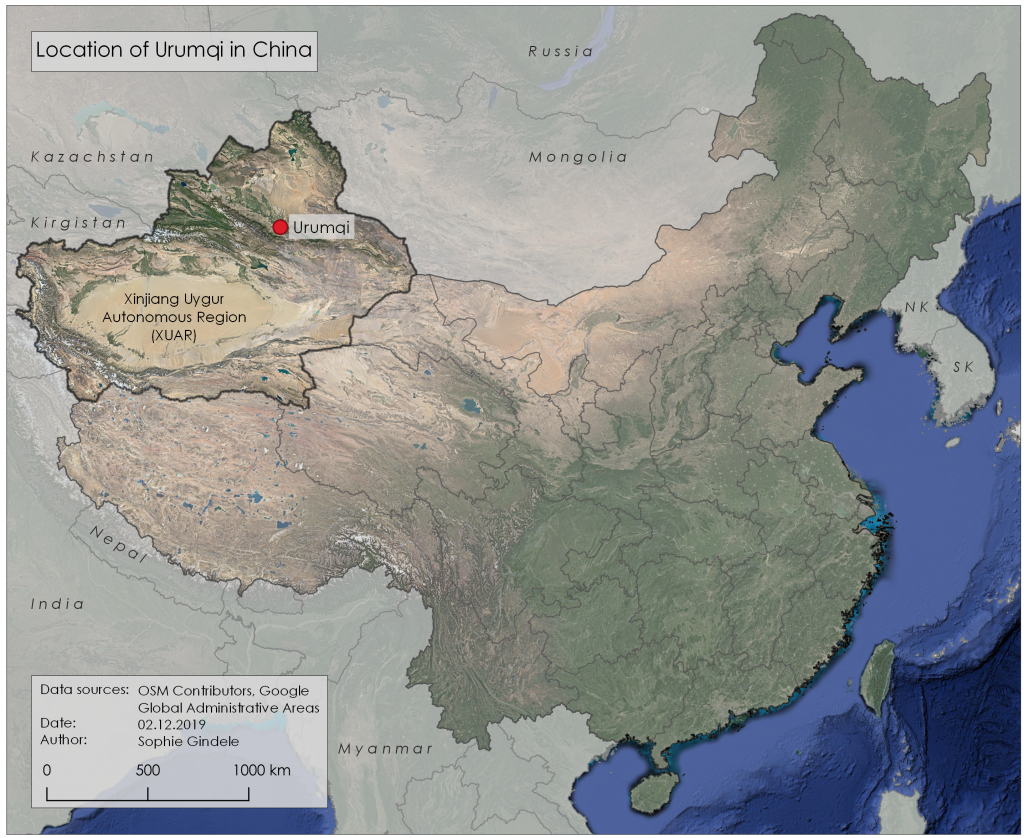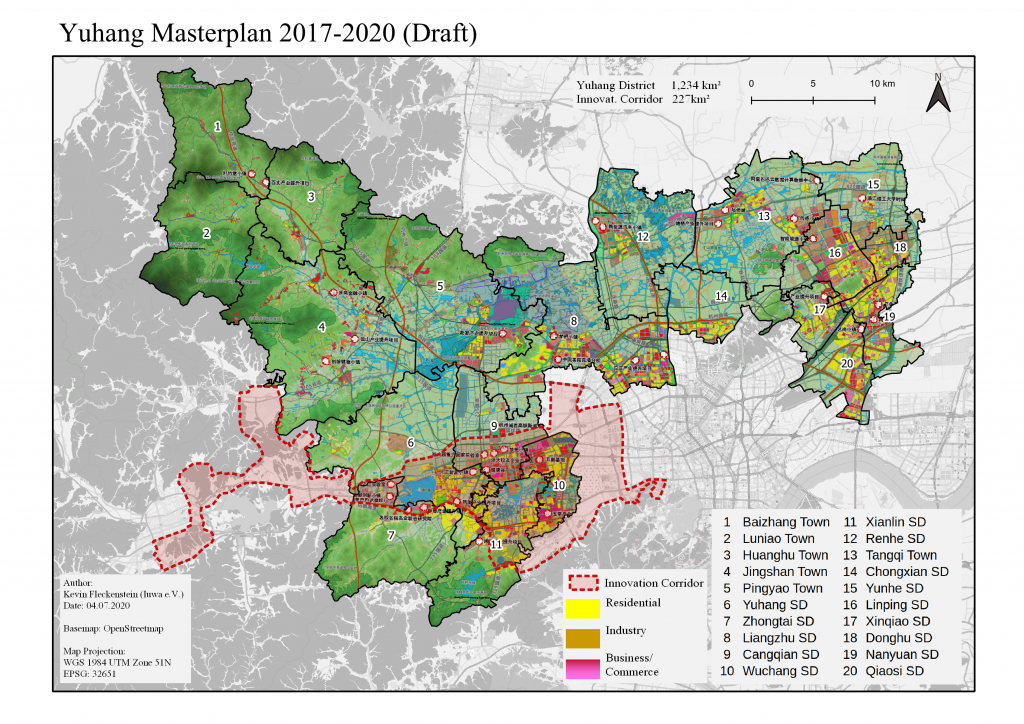
Urumqi Economic and Technological Development (UETD) District
In the initial stage of the definition phase, the RESURC project focused on the Urumqi Economic and Technological Development (UETD) District of Urumqi City.
Urumqi is the capital of the Xinjiang Uygur Autonomous Region in North-West China. It is situated in a high-continental and semi-arid environment within a narrow irrigated belt embraced by mountain ranges in the West, East and South and the desert to the North. Nonetheless, it has developed from a town of 100,000 inhabitants (1949) to a bustling 3.5 million strong metropolis (2017), rightly called the “Regional Capital of Central Asia”. Considering the current administrative reform, involving a merger with the surrounding Changji Prefecture, the U-Chang region today is the largest metropolitan area in Central Asia with a total population of about 5.1 million.
Urumqi’s economy is developing rapidly at an average growth rate of 12.3% p.a. since 2000. Although the city’s tireless pace of development is still reliant on the richness of the region’s natural resources, it continues to diversify in its expansion of the manufacturing industries, which extend from food and biological products, metal, and machinery, to new energy equipment, automotive industry and its component supply.
In 1994, the “Urumqi Economic and Technological Development (UETD) Zone” was established as an industrial park of national level with a starting area of only five km². Since then, its development has gained momentum and the park size has expanded continuously. As a strategic step towards the U-Chang integration and the formation of a new UETD District, the park underwent an administrative merger with the surrounding Toutunhe District in 2011. Today, 320,000 people are living here on the total area of around 280 km². With the half of the area being industrial quarters, more than 8,000 companies of all sizes and industries have settled in the UETD district. They contribute more than 40% of the entire industrial output of Urumqi. VW too decided to gain a foothold there and laid the foundation stone for its China-wide sixth production base in April 2013. With the inauguration of the new railway station for high-speed connections, UETD has become now Xinjiang’s largest hub for railway transportation.

The fast advancing urbanisation and industrialisation create challenges concerning sustainable resource deployment and climate-resilient development. Air pollution remains a significant environmental problem, especially in winter. Not only pollutants like SO2, NxO and soot from power plants and industrial production but also the rapid increase in automobiles and meteorological influences of warmer winters are sources of the current pollution. A profound concept promoting renewable energy and energy efficiency in high quality is thus indispensable. Water scarcity is a crucial factor for the development of the economy and society in Urumqi. With the increasing water withdrawals and retreating Glacier No. 1 as the primary water source, the exploitation of surface water reached its limit and groundwater’s share of the total supply increased by 15%, leading to the decline of the water table and degradation of the water source area. The bottleneck between increasing demand and decreasing availability intensifies the competition for water use among sectors. A more efficient water management concept is of vital importance, especially considering the strained water quality further endangers the regional water security due to pollution and salinisation of groundwater. Moreover, rapid growth has also resulted in significant waste problems. Both industrial and municipal wastes increased dramatically over the last decade. Some problems, such as the processing of coal gangue, remain intractable. The separation and recycling of municipal wastes are still heavily limited. The collected wastes are mainly disposed in landfills, which often lead to the further environmental burden. Waste incineration, though gaining increasing weight, is still limited due to the abundance of organic wastes. Due to the absence of an environment-friendly waste reduction and recycling concept, the waste problem is currently mostly approached by increasing landfill capacities which is merely a problem displacement and not a solution and implies further environmental repercussions.

Hangzhou West Science and Technology Innovation Corridor, Yuhang District
Since 01.01.2020, the research area of the RESURC project has been changed to the City of Hangzhou.
Named “Garden City” by the UN-Habitat in 2002, Hangzhou generally has better performance in designing and operating the city and its infrastructure today, in comparison with many Chinese cities. However, it is also struggling to adapt to the rapidly changing circumstances brought about by the growing population and transforming economy. Many suburban areas, which served as nodes for industrial and agricultural production with small towns, now turn to be the next hotspot of urbanisation.

With the planning and constructing of “Hangzhou West Science and Technology Innovation Corridor” (HW-STIC), which spreads across Hangzhou’s three districts of Xihu, Yuhang, and Lin’an, this area gained significant momentum, – especially Yuhang marking an extraordinary development pace of its Gross Domestic Product by 12.5% and population growth of 8.4% p.a. since 2015. Associated with the transformation of the industrial structure towards information technology, medical and health care, new material and machinery, and financing sector, new IPs and technology parks (TPs) are emerging, while older ones are to undergo upgrading processes. With its 1.6M inhabitants and 28.9B Euro GDP, Yuhang is currently the strongest administrative unit in Hangzhou.
At the same time, however, Yuhang also faces multiple challenges, especially in the HW-STIC as a model project for “Industry-City-Integration”. These include the fields of land use, infrastructure for supply and disposal, mobility, urban-rural relations, etc. As such, the overall city and its districts face tremendous challenges for which they are not well prepared yet, especially under the consideration of both future growth and specific impacts of climate change.

However, in a city with high development dynamics like Hangzhou, there are also significant opportunities for creating and realising concepts promoting both mitigation and adaptation. At the forefront of a rapidly growing city with major development potential, the special economic zone HW-STIC targets at a sustainable concept with a mix and integration of different urban structures and functions. Those planning and implementation processes are the most promising which can embrace adaptive and flexible structures on different scales with transformational decision-making to enhance resilience and avoid locking additional emissions into the future. The options and strategies exploit synergies between industry and residential areas as well as among other sectors or tasks are in particular efficient.
As a result, developing the selected investigation area in Yuhang towards sustainable urban quarters can exemplify suitable options of a “future city” particularly for Hangzhou and its bordered regions in Yangtze Metropolitan Area, as well as for other regions in China.
